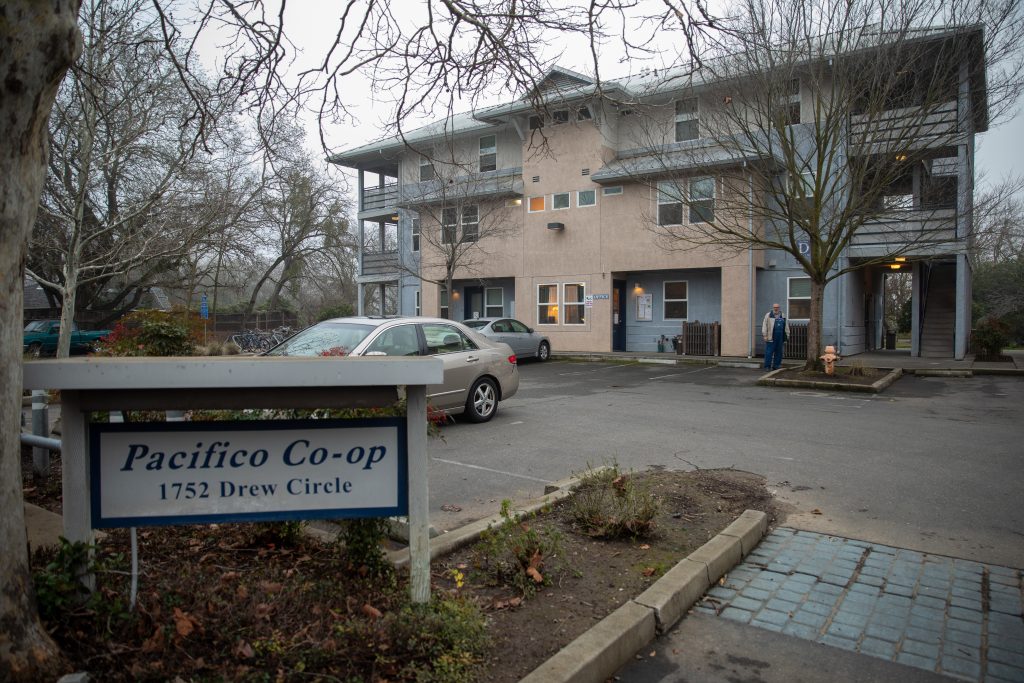
On Thursday, a community meeting about changes to two of the buildings at Pacifico turned into an opportunity for frustrated neighbors to vent about the current conditions, which they claim are creating an ongoing nuisance at Pacifico and by extension the adjacent neighborhoods.
The Pacifico site is currently owned by the city of Davis, but has 48 units that are being administered by Yolo County housing. The proposed project differs somewhat from the current uses and it “involves interior renovations to two of the existing buildings at the Pacifico Apartments.”
According to an application for a Conditional Use Permit (CUP) filed with the city, “The first and second floors of Building A will be used as an Adult Residential Treatment Facility (ART) operated by North Valley Behavioral Health, that will provide a community-based residential treatment, typically for a period of up to 18 months for adults with mental illness at risk of being placed in an institutional setting, and for those transitioning back into a community from an institutional placement.”
In addition, the first floor of Building B would serve as the Yolo County Navigation Center, operated by Communicare.
According to their application, “The Navigation Center will assist adults seeking social services to access the supports they need to maintain their mental health. It will also provide services to adults with mental illness to receive the support and services they need to ensure that a more serious mental health crisis does not develop. This could entail driving adults seeking treatment to and from other appointments at different locations.”
The original use was a Student Housing Cooperative which opened in May 1999. However, that use has been ceased and the property is currently serving low income residents. “The proposal would be to add services to the affordable housing component to include community-based outpatient mental health care, and residential treatment for supporting those with mental health needs, geared towards increasing self-sufficiency and independence.”

Since this past fall, neighbors have been coming forward to city council to complain about ongoing problems at the Pacifico site – this includes drug use, drug sales, litter, noise, expletives, people loitering and more. There is a good deal of dispute as to whether the facility itself and its current residence are creating this nuisance or rather a part of a larger pattern of problems in the area.
According to a memo from Lisa Baker to the city, dated October 2, 2018, “YCH is mindful of its role in looking at affordable housing policy, neighborhood and site conditions. As a result, we proactively responded to emails from neighbors and also met with the neighbors when we were apprised of their issues in September, prior to the public comment at the last City Council meeting.”
She said that they have passed along their neighborhood concerns to Chief Pytel of the Davis Police Department, “and also pledged to work with the neighborhood on joint issues as well as to address issues that we could control.”
She wrote that they have spoken with the police, “regarding unauthorized loiterers who are not residents and provided them with a photo” and she said, “We have been out in the field with the Chief looking at existing City conditions around homelessness to determine how we can best partner with the City and neighbors to mitigate conditions.”
At the meeting, the county discussed some mitigation measures, including some sort of barrier between the bike path and Pacifico in hopes of keeping outside problems from reaching Pacifico.
Reports from the neighbors have varied, but some complain that staff at the facility is often unavailable to take their complaints, while the manager of a nearby apartment complex indicated that, while problems still exist, things have somewhat improved from the fall
At the meeting, one resident, John Slater, drew a clear distinction between their complaints about the current users and the new proposal.
He said they would prefer an all-residential facility rather than deal with the current uses. He argued that the city needs to address the current uses.
He explained, “If it were all going to be a residential facility – you would have more support.” He added, “The concerns are not about the new uses – the concerns are about additional uses.”
Mr. Slater suggested that they withdraw the request for the CUP, address current problems, and then re-file for the CUP.
On the other hand, many residents are concerned with the concentration of people with mental illnesses in their neighborhood.
Matthew Lang suggested that a recent development on Mace had given its in-lieu fees to Pacifico. He explained, “What they are doing is concentrating into one facility that has a lot of beds a huge number of people with mental illness.
“We are actually ‘ghettoizing a neighborhood,’” he explained, likening it to Cabrini Green, the facility from Chicago. He suggested instead of one large facility that concentrates the population, we should have a bunch of small facilities across the town to service those needs.
Supervisor Jim Provenza attended the meeting on Thursday and told the Vanguard, “I am going to look into the situation.
“I understand that some changes have already been made (including removal of problem tenants) and others are planned,” he explained.
He said, “I want to learn what more needs to be done and will be in a better position to comment at that time. Also, the problem is broader than Pacifico. We will need to bring the city into the discussion.”
Councilmember Lucas Frerichs also attended the meeting. He said, “This is the first I’d heard specific details about the proposed supplemental uses at Pacifico.”
He noted that many of the neighbors in attendance “again raised concerns they’ve been expressing (to the council) about some of the activities taking place in the neighborhood around Pacifico.
“We’ve been in communication with Yolo County Housing (YCH) for several months about the need for additional monitoring and oversight of Pacifico,” Councilmember Frerichs said.
“YCH has met with neighbors, and folks have said they’ve started to see improvements, although I believe more work is needed on the underlying existing issues, which are separate from the newly proposed residential treatment units and resource center,” he added.
The councilmember said, “I’ve committed to meeting with the neighbors, (and to) listen to their concerns and work on solutions that will benefit the neighborhood.”
The neighbors at the meeting seem to believe that the city and county need to address current concerns before going forward with an additional project at this site. The county’s perspective is that they are already working to address these concerns, but they believe by creating facilities to deal with mental illness, they will be better equipped to address these concerns.
—David M. Greenwald reporting







Build the Wall!
( . . . and make Solano County pay for it)
Along those lines, the county person start to say they are going to build a wall, but corrected herself…
THAT is hilarious on several levels . . . thanks for the nugget.
Still not clear – the problem is the current conditions not the proposal. What is the city going to do to resolve the current conditions?
To get back to the warrier (wall/barrier), I am puzzled what this is to do. The management company, I believe, believes the problem is coming from the bike path, the neighbors seem to think the problem is coming from within the complex. So, is the intent of the warrier to keep people in, or keep people out? Is perhaps the problem people on the inside attracting more people from the outside? It doesn’t seem that there is a call for a warrier all along the bike path, so how is it only one complex has a leakage? I’ve always rather found one of the nice things about the design is the complex’s incorporation with the bike path. And how exactly does a warrier stop the unwanted beings? This isn’t like the US border wall which is impenetrable without some major effort, and one would assume there will be an end to the warrier, or a gate, or a way to knock it down or climb over it, or a way in the front. So what exactly is the plan here? A warrier is only as strong as it’s weakest point of penetration.